


Framed or unframed, desk size to sofa size, printed by us in Arizona and Alabama since 2007. Explore now.
Shorpy is funded by you. Patreon contributors get an ad-free experience.
Learn more.

- Freeze Frame
- Texas Flyer wanted
- Just a Year Too Soon
- WWII -- Replacing men with women at the railroad crossing.
- Yes, Icing
- You kids drive me nuts!
- NOT An Easy Job
- I wonder
- Just add window boxes
- Icing Platform?
- Indiana Harbor Belt abides
- Freezing haze
- Corrections (for those who care)
- C&NW at Nelson
- Fallen Flags
- A dangerous job made worse
- Water Stop
- Passenger trains have right of way over freights?
- Coal
- Never ceases to amaze me.
- Still chuggin' (in model form)
- Great shot
- Westerly Breeze
- For the men, a trapeze
- Tickled
- Sense of loneliness ...
- 2 cents
- Charm City
- What an Outrage
- Brighton Park
Print Emporium
Stacked Decks: 1911
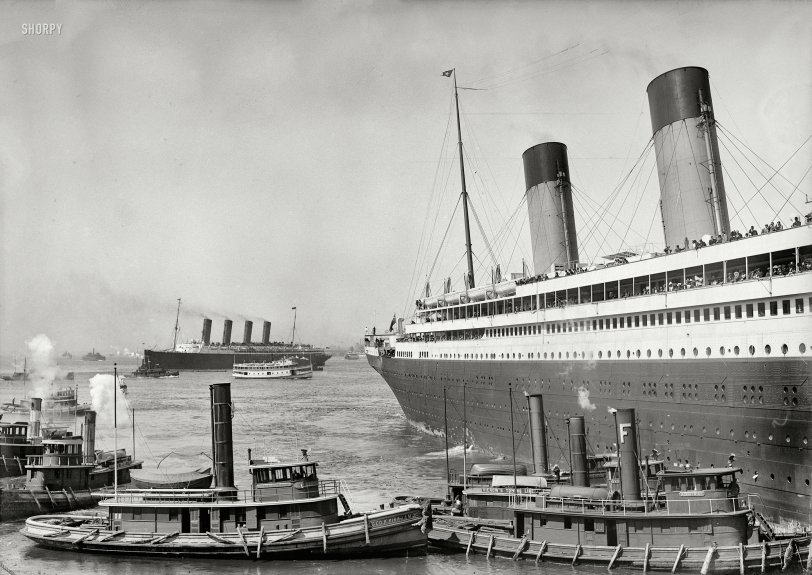
New York. June 21, 1911. "White Star liner S.S. Olympic guided by tugboats Kirkham and Admiral." Detroit Publishing glass negative. View full size.
Lucky(?) lady aboard
Somewhere aboard the Olympic at the time of the photo was the nurse/stewardess Violet Jessop. She was aboard when the ship was involved in a major collision a few months later. She transferred to service on the then-new Titanic, and we know what happened there. Jessop was one of the survivors.
She then went on to work on the Britannic as a nurse during WWI. She was aboard when that ship was struck by a mine and sunk. She survived that incident, too. After all that, Jessop continued her career aboard ocean liners, apparently without further excitement but perhaps with a few extra gray (grey?) hairs.
In the Movies
I believe I see a movie camera on the Boat Deck. Newsreel?
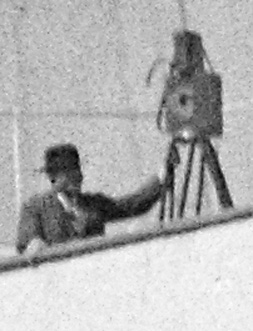
Visit RMS Queen Mary
Though launched in the 1930s, a generation later than these two fine ocean liners, the Long Beach-moored QM is the only ship remaining to suggest the vast size and elegance of Atlantic liners in service prior to World War 2. I'm so happy it's only a few hours drive from my home and visit at least once every year.
The Old Grey Lady confirms it
An article in the next day's New York Times (entitled "Biggest of Liners Gets Noisy Welcome") confirms that the other ship is the ill-fated Lusitania: "The Cunarder Lusitania swung out into the river at 9 o'clock, just after the Olympic had passed and gave the small army of photographers on the piers a chance for a good picture of the two big ships." The Lusitania failed to salute the Olympic, however, a lapse that the Times treated as an oversight by the Lusitania's skipper.
Among the passengers on the Olympic for this voyage was James Bruce Ismay, president of the ship's owner. Ismay was especially proud of the Olympic's squash and racquet court. He noted that "there were a few minor details that might be corrected on the next ship, the Titanic," but "nothing of any importance."
Re: Portholes
Correct. Here is what it looked like from the inside:
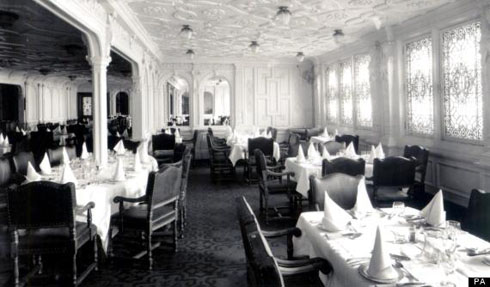
Tug Geo. K Kirkham
Tug George K Kirkham: built 1900 at Athens, N.Y., 76' long, 95 gross tons.
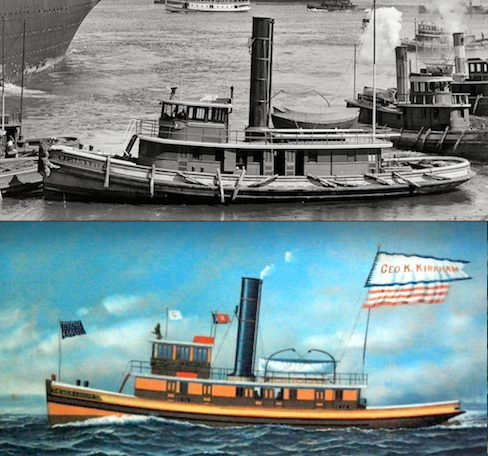
Jules Is Correct
The Cunarder in the background is certainly Lusitania of 1907. She differed from her almost identical sister Mauretania in the type of ventilators. Lusitania had a type described often as "pot-lids", with the visible portions looking like a 6-quart stew pot with the lid tilted, rather than the bent-horn type more commonly seen. Lusitania is easily identified by this feature that very few ships (and none anything like her) had.
Portholes
The double portholes provided light to the 1st and 2nd class dining saloons on D-deck. However, I'm pretty sure that the light was filtered through translucent, leaded glass windows on the interior. A view of the North Atlantic (and the moving horizon) was not deemed desirable for dining passengers.
Olympic
This was the Olympic's first arrival in NYC; she sailed from Southampton on June 14. Her captain was Edward J. Smith, who would later be in charge of the Titanic on its ill-fated maiden voyage the following year.
The ship behind the Olympic does look like a Cunarder. It looks to me like the Lusitania:
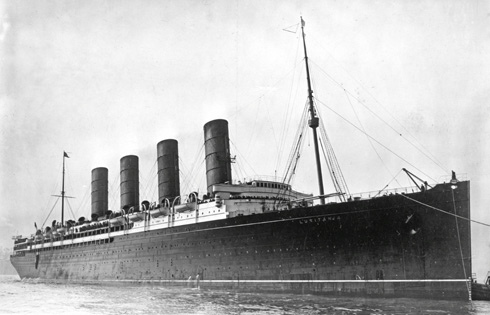
What Hustle...What Bustle!!
Lower New York Harbor was alive with small, and BIG craft during the early 20th Century as evidenced here. From just the narrow view of one photograph, I counted a dozen or so small boats and, of course, the two Behemoths. We've identified the Olympic, could the one in the background be a Cunarder?
Besides the Kirkham and the Admiral, there are two other tugs toiling up the starboard side of the Olympic as well.
Great action shot....thank you, Dave.
Note to Jules....The bow configuration looks correct for the RMS Lusitania. This is sad commentary....a doomed ship in the background and a doomed Captain of his next command in the foreground.
Seeing double
Curious about those over & under double portholes. Were they designed to give additional light and views to upper class passenger cabins? Or improved ventilation for crowded below decks areas?
























On Shorpy:
Today’s Top 5